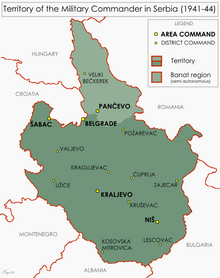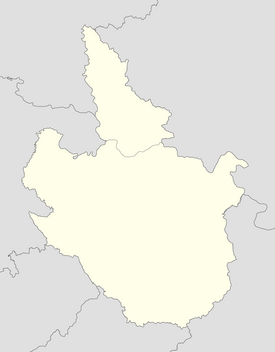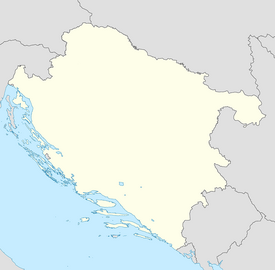Russian Protective Corps
| Russian Protective Corps | |
|---|---|
| Active | 1941–1945 |
| Allegiance | Anti-partisan operations |
| Size | 17,090 troops (total membership) 11,197 troops (maximum strength) |
| Engagements |
|
| Commanders | |
| Notable commanders | Mikhail Skorodumov Boris Shteifon † Anatoly Rogozhin |
The Russian Protective Corps (
Background and formation
Before World War II In the Balkans there were approximately 15,000 White Russian émigrés in the Balkans - their families had fled there in the aftermath of the 1917 Russian Revolution. [1] General Pyotr Nikolayevich Wrangel relocated 25,000 of his Southern White Army to Yugoslavia through negotiations with the Yugoslav government in 1921.[2] On 6 April 1941, Axis forces invaded the Kingdom of Yugoslavia. Poorly equipped and poorly trained, the Royal Yugoslav Army was quickly defeated.[3] The Axis powers then dismembered Yugoslavia, with Serbia being reduced to its pre-1912 borders and placed under German military occupation.[4] The Germans selected General Milan Nedić, a pre-war politician who was known to have pro-Axis leanings, to lead the collaborationist Government of National Salvation in the German-occupied territory of Serbia.[5] Over the course of the uprising in Serbia in the summer of 1941, communist-led partisans killed approximately 300 Russian émigrés and injured many more, sometimes in acts of vengeance. In response, local Russians began to organize themselves into self-defense units.[6] At the time, there were an estimated 10,000 Russian men within the former borders of Yugoslavia, the majority of whom lived in occupied Serbia.[7]

The Russian Protective Corps, founded in
Skorodumov was elderly, ill, and not well known to the rank-and-file of White Russian émigrés.[12] Two days after the formation of his Corps, the Gestapo arrested him,[13] and command passed to Lieutenant General Boris Shteifon,[11] who was said to have had "warm and friendly relations with [Milan] Nedić".[4] The Germans envisaged a force 3,000-strong and organized into three regiments, tasked with protecting factories, other industrial concerns, and mines that were producing materials to support the German war-effort.[7][14] The Corps initially consisted of a single regiment, organized into four battalions. Major General Egorov commanded the 1st Battalion, Colonel Shatilov the second, Colonel Endrzheevskiy the third, and Colonel Nestrenko the fourth. A second regiment was set up on 18 October,[15] commanded by Colonel Zhukov.[16] At first, the group was an independent force reporting to the German plenipotentiary general for economic affairs, NSFK-Obergruppenführer Franz Neuhausen.[17]
Operations
General
Although its ultimate aim was to help defeat the communist forces in the
While guarding facilities, members of the Corps were largely assigned to manning brick
Early actions
The Corps was initially used to guard mines at Krupanj in the west of the territory, and later at Bor in the west and Trepča in the south.
The 3rd Regiment was established in
On 30 November, the 4th Regiment was disbanded, its 1st Battalion assigned to the 1st Regiment and the rest of its manpower assigned to the 2nd Regiment.[29] On 1 December 1942, the Corps was incorporated into the Wehrmacht and all its members were required to swear an oath to German leader Adolf Hitler.[4] The Corps grew in numbers throughout 1942, following an influx of volunteers from Bulgaria, Croatia, Romania and Greece. By late 1942, the Corps totalled about 7,500 men, all of whom were Russian.[7][19] During the re-organization, an attempt was made to expand the Corps further by recruiting Soviet POWs, but the first experiment with 300 POWs proved unsuccessful and was not repeated.[31] On 9 December 1942, the 1st Regiment started to be transformed with the arrival of Kuban Cossacks led by Major General Naumenko.[22] By January 1943, it consisted entirely of Cossacks.[32] On 17 March 1943, Major General Gontarev replaced Shapilov as commander of the 3rd Regiment.[24] The 1st Regiment fought in Loznica in April and participated in a large operation in Zapolje just south of Krupanj over the border with the NDH on 11–15 May, where it engaged in heavy combat with Partisan forces.[32] From 1–8 July, the regiment was again stationed in Loznica and Ljubovija, participating in the defence of the Drina Bridge at Zvornik against the Partisans. During this time the regiment allowed the passage of 379 wounded Croatian soldiers and civilians, 1,000 healthy soldiers and as many refugees, sustaining casualties of two killed and seventeen wounded. It clashed with the Partisans over the village of Nedelica on 19 July.[33] Meanwhile, the 2nd Regiment clashed with the Partisans around the town of Negotin.[34] The 4th Regiment was re-established on 15 December, and was based in Jagodina, Paraćin and Ćuprija in the centre of the occupied territory.[35]
Retreat, surrender, disbandment
From the spring of 1944, the Corps focused increasingly on fighting the Partisans penetrating Serbia from Bosnia and the
In September, the Corps reached its peak of 11,197 members.
Elements of the 2nd Regiment arrived in Šabac on 22 October, then moved to
In January 1945, elements of the Corps participated in the German capture of
Immediately after disarmament and transfer to Austrian territory, the Corps settled in the Viktring International Camp. Next, the Corps moved to a separate camp in the area of Kl. St. Veit - Tigring and received from the British a small amount of small arms to maintain order and protect against partisan attacks. After examining the history of the Corps, the British decided to demobilise it in October. Its members were then sent in the Kellerberg DP Camp northwest of Villach, Austria; Rogozhin on 1 November 1945 issued an order that notified his subordinates of demobilisation.[53] The Corps' badge was a white militia cross, in the middle of which was a Gallipoli cross with the dates "1917-1921, 1941-1945", indicating two periods of the anti-communist struggle. The badge was established by Order to the Russian Corps N100 of July 26, 1945. Those who had the right to wear this sign received a corresponding certificate signed by the commander and with the seal of the Russian Corps. In emigration, these signs were worn in a miniature (“tailcoat”) version or in a large size on the Cossack uniform. Most of the already disarmed ranks of the Russian Corps spent several years in the DP camp Kellerberg (Austria), which gave them the right to wear a second badge for those who were in this camp. Former members of the Corps were subsequently allowed to resettle in the West, mainly in the United States and Argentina.[48][18] In exile, veterans formed the Union of Officials of the Russian Corps (СЧРК- Союз Чинов Русского Корпуса), registered as the Union of St. Alexander Nevsky.
Order of battle
At its maximum strength, the Russian Corps was composed of:[18]
- 1st Cossack Regiment General Zborovski
- Infantry Regiments II, III, IV, V
In May 1942, the Corps was divided into two brigades.[30] The 4th Regiment was disbanded on 30 November 1942,[29] and re-established on 15 December 1943.[35] The 5th Regiment was created on 18 January 1944.[38]
Commanders
The Russian Corps had three commanders during its existence:[6][11][45]
| No. | Portrait | Commander | Took office | Left office | Time in office |
|---|---|---|---|---|---|
| 1 | General Mikhail Skorodumov (1892–1963) | 12 September 1941 | 14 September 1941 | 2 days | |
| 2 | Lieutenant-General Boris Shteifon (1881–1945) | 15 September 1941 | 30 April 1945 † | 3 years, 227 days | |
| 3 | Colonel Anatoly Rogozhin (1893–1972) | 30 April 1945 | 12 May 1945 | 12 days |
Uniform
Members of the Corps wore the uniform of the Russian Imperial Army from 12 September 1941 to 30 November 1942 as well as the Czechoslovakian helmet. The uniform was sometimes worn with pips of the Royal Yugoslav Army, alongside special rank insignia on the collar. Wehrmacht uniforms and insignia were adopted on 1 December 1942,[18] but the old uniforms continued to be worn for some time.[54]

Rank insignia
Collar patches and sleeves showed the actual rank in the Corps, while those who have held Tsarist rank wore rank insignia in the form of traditional shoulder straps denoting their former rank. Both types of insignia were improvised using rank stars from the Royal Yugoslav Army.[55]
| Rank insignia | Russian | German |
|---|---|---|
| Generalmayor | Generalmajor | |
| Polkovnik | Oberst | |
| Podpolkovnik | Oberstleutnant | |
| Mayor | Major | |
| Kapitan | Hauptmann | |
| Poruchik | Oberleutnant | |
| Podporuchik | Leutnant | |
| Feldfebel | Feldwebel | |
| Unterofitzer | Unteroffizier | |
| Yefreytor | Gefreiter | |
| Source: | [55] | |
Notes
- ^ McAteer 2009, p. 264 Question 15,000 figure..
- ISBN 0199250219.
- ^ Cohen 1996, p. 28.
- ^ a b c d e f g h Cohen 1996, p. 50.
- ^ Singleton 1985, p. 182.
- ^ a b c Timofejev 2007, p. 45.
- ^ a b c d e f Tomasevich 2001, p. 192.
- ^ a b Tomasevich 2001, p. 191.
- ^ a b c d Cohen 1996, p. 49.
- ^ a b Tomasevich 2001, pp. 191–192.
- ^ a b c d Thomas & Mikulan 1995, pp. 21–22.
- ^
ISBN 9780804779241. Retrieved 4 October 2022.
Skorodumov was chosen by the Germans, but he was sick and old and not well known to the rank and file of Russian emigres. He was replaced within the first month by his chief of staff, General Boris Aleksandrovich Steifon [...].
- ^
Батшев, Владимир (2005). Vlasov: opyt literaturnogo issledovaniya Власов: опыт литературного исследования [Vlasov: an essay in literary investigation]. Власов: опыт литературного исследования, ISBN 9783936996142 (in Russian). Vol. 1 (2 ed.). Мосты. p. 386. ISBN 9783936996128. Retrieved 4 October 2022.
14 сентября Скородумова пригласили в Гестапо и арестовали. [On 14 September Skorodumov was invited to the Gestapo and arrested.]
- ^ Abbott 1983, p. 22.
- ^ Vertepov 1963, pp. 38–39.
- ^ Vertepov 1963, p. 40.
- ^ Timofejev 2007, p. 47.
- ^ a b c d e Thomas & Mikulan 1995, p. 22.
- ^ a b c d e Timofejev 2010, p. 47.
- ^ Mordwinkin 2003, p. 69.
- ^ Tomasevich 2001, p. 185.
- ^ a b Vertepov 1963, pp. 79–81.
- ^ Vertepov 1963, p. 81.
- ^ a b c Vertepov 1963, pp. 120–121.
- ^ Vertepov 1963, pp. 73–75.
- ^ Vertepov 1963, p. 76.
- ^ Vertepov 1963, p. 82.
- ^ Vertepov 1963, p. 77.
- ^ a b c Vertepov 1963, p. 83.
- ^ a b Vertepov 1963, pp. 77–78.
- ^ Tomasevich 2001, p. 193.
- ^ a b Vertepov 1963, p. 116.
- ^ Vertepov 1963, p. 117.
- ^ Vertepov 1963, p. 119.
- ^ a b c d e f g h Vertepov 1963, pp. 157–160.
- ^ a b c Cohen 1996, pp. 49–50.
- ^ a b c d e f Vertepov 1963, pp. 144–151.
- ^ a b c d Vertepov 1963, pp. 160–163.
- ^ a b Vertepov 1963, pp. 155–157.
- ^ a b c Vertepov 1963, pp. 151–155.
- ^ Tomasevich 1975, pp. 417–418.
- ^ a b Tomasevich 1975, p. 394.
- ^ Vertepov 1963, pp. 25–26.
- ^ Vertepov 1963, p. 24.
- ^ a b Vertepov 1963, p. 27, 348–349.
- ^ Mordwinkin 2003, p. 87.
- ^ Vertepov 1963, pp. 28, 366, 369.
- ^ a b c Puškadija-Ribkin 2006, p. 253.
- ^ Vertepov 1963, p. 28.
- ^ Radanović 2016, p. 189.
- ^ Timofejev 2010, p. 48.
- ^ Vertepov 1963, p. 391–392.
- ^ Vertepov 1963, p. 399–400.
- ^ Abbott 1983, p. 35.
- ^ a b Thomas & Mikulan 1995, pp. 34.
References
- Books
- Abbott, Peter (1983). Partisan Warfare 1941–45. ISBN 978-0-85045-513-7.
- ISBN 978-0-89096-760-7.
- McAteer, Sean M. (2009). 500 Days: The War in Eastern Europe, 1944–1945. ISBN 978-1-4349-6159-4.
- Puškadija-Ribkin, Tatjana (2006). Emigranti iz Rusije u znanstvenom i kulturnom životu Zagreba. ISBN 953-7130-36-3.
- Mordwinkin, George (2003). Russian White Guards. ISBN 978-1-55395-548-1.
- Radanović, Milan (2016). Kazna i zločin:Snage kolaboracije u Srbiji. Rosa Luxemburg Stiftung.
- Singleton, Frederick Bernard (1985). A Short History of the Yugoslav Peoples. ISBN 978-0-521-27485-2.
- Thomas, Nigel; Mikulan, Krunoslav (1995). Axis Forces in Yugoslavia 1941–45. ISBN 978-1-85532-473-2.
- Timofejev, Aleksej (2007). "Political Activity of Russian Emigration in Yugoslavia 1941–1945" (PDF). Tokovi Istorije (3). New York. Archived from the original (PDF) on 3 December 2013. Retrieved 17 August 2013.
- Timofejev, Aleksej (2010). Rusi i drugi svetski rat u Jugoslaviji [Russians and the Second World War in Yugoslavia] (in Serbo-Croatian). ISBN 978-86-7005-089-1.
- ISBN 978-0-8047-0857-9.
- Tomasevich, Jozo (2001). War and Revolution in Yugoslavia, 1941–1945: Occupation and Collaboration. ISBN 978-0-8047-3615-2.
- Vertepov, Dmitriĭ Petrovich (1963). Русский Корпус на Балканах во время II Великой Войны 1941–1945 г.г. [Russian Corps in the Balkans at the Time of the Second Great War] (PDF) (in Russian). OCLC 976722812.
- Journals
- Hehn, Paul N. (1971). "Serbia, Croatia and Germany 1941–1945: Civil War and Revolution in the Balkans". Canadian Slavonic Papers. 13 (4). University of Alberta: 344–373. JSTOR 40866373.
Further reading
- Beyda, Oleg (2014). "'Iron Cross of the Wrangel's Army': Russian Emigrants as Interpreters in the Wehrmacht". The Journal of Slavic Military Studies. 27 (3): 430–448. S2CID 144274571.
- M.V. Nazarov, The Mission of the Russian Emigration, ISBN 978-5-86231-172-3
- I.B. Ivanov, N. N. Protopopov, Russkii Korpus Na Balkanakh Vo Vremia II Velikoi Voiny, 1941–1945: Vospominaniia Soratnikov I Dokumenty Sbornik Vtoroi, ISBN 978-5-288-02307-1
- Badges of the Russian Corps and DP Camp Kellerberg
- Official Photo Archive of the Russian Corps





